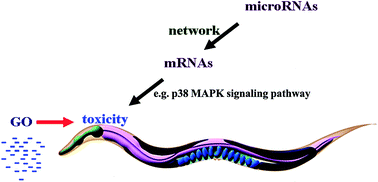A microRNAs–mRNAs network involved in the control of graphene oxide toxicity in Caenorhabditis elegans†
Abstract
A previous study has suggested that microRNAs (miRNAs) are involved in the control of the toxicity of graphene oxide (GO) in the in vivo Caenorhabditis elegans assay system. However, it is still unclear for miRNAs–mRNAs networks functioning to regulate GO toxicity. In the present study, we first employed a HiSeq 2000 sequencing technique to examine dysregulated mRNAs in GO-exposed nematodes and identified 970 up-regulated and 995 down-regulated mRNAs. Analysis of both gene ontology and the Kyoto Encyclopedia of Genes and Genomes (KEGG) pathway implied that these dysregulated mRNAs mediated many important biological processes. Some dysregulated genes encode the JNK signaling pathway, which was proven to be involved in the control of GO toxicity. In the JNK signaling pathway, JKK-1 and MEK-1 function in the same pathway as JNK-1 to regulate GO toxicity. Moreover, we raised a miRNAs–mRNAs network, which at least potentially explained molecular basis for the roles of oxidative stress, intestinal barrier, and defecation behavior in regulating GO toxicity. The established link between miRNAs and mRNAs provides the key basis for further elucidating the molecular mechanisms of GO toxicity in organisms.


 Please wait while we load your content...
Please wait while we load your content...